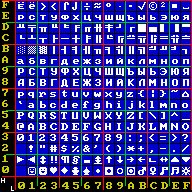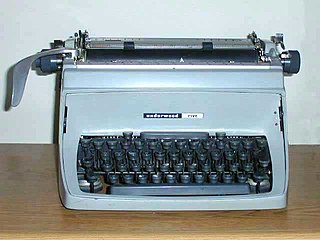Related Research Articles

In computing and electronic systems, binary-coded decimal (BCD) is a class of binary encodings of decimal numbers where each digit is represented by a fixed number of bits, usually four or eight. Sometimes, special bit patterns are used for a sign or other indications.

In computing, a nibble (occasionally nybble or nyble to match the spelling of byte) is a four-bit aggregation, or half an octet. It is also known as half-byte or tetrade. In a networking or telecommunication context, the nibble is often called a semi-octet, quadbit, or quartet. A nibble has sixteen (24) possible values. A nibble can be represented by a single hexadecimal digit and called a hex digit.

A palindrome is a word, number, phrase, or other sequence of characters which reads the same backward as forward, such as madam, racecar. There are also numeric palindromes, including date/time stamps using short digits 11/11/11 11:11 and long digits 02/02/2020. Sentence-length palindromes ignore capitalization, punctuation, and word boundaries.
In computing, endianness is the order or sequence of bytes of a word of digital data in computer memory. Endianness is primarily expressed as big-endian (BE) or little-endian (LE). A big-endian system stores the most significant byte of a word at the smallest memory address and the least significant byte at the largest. A little-endian system, in contrast, stores the least-significant byte at the smallest address. Endianness may also be used to describe the order in which the bits are transmitted over a communication channel, e.g., big-endian in a communications channel transmits the most significant bits first. Bit-endianness is seldom used in other contexts.

A typewriter is a mechanical or electromechanical machine for typing characters similar to those produced by a printer's movable type. Typically, a typewriter has an array of keys, and each one causes a different single character to be produced on the paper, by means of a ribbon with dried ink struck against the paper by a type element similar to the sorts used in movable type letterpress printing. On some typewriters, a separate type element corresponds to each key; others use a single type element with a different portion of it used for each character. At the end of the nineteenth century, the term typewriter was also applied to a person who used a typing machine.

Optical character recognition or optical character reader (OCR) is the electronic or mechanical conversion of images of typed, handwritten or printed text into machine-encoded text, whether from a scanned document, a photo of a document, a scene-photo or from subtitle text superimposed on an image.
Constrained writing is a literary technique in which the writer is bound by some condition that forbids certain things or imposes a pattern.

In computing, a hardware random number generator (HRNG) or true random number generator (TRNG) is a device that generates random numbers from a physical process, rather than by means of an algorithm. Such devices are often based on microscopic phenomena that generate low-level, statistically random "noise" signals, such as thermal noise, the photoelectric effect, involving a beam splitter, and other quantum phenomena. These stochastic processes are, in theory, completely unpredictable, and the theory's assertions of unpredictability are subject to experimental test. This is in contrast to the paradigm of pseudo-random number generation commonly implemented in computer programs.

A stenotype, stenotype machine, shorthand machine or steno writer is a specialized chorded keyboard or typewriter used by stenographers for shorthand use. In order to pass the United States Registered Professional Reporter test, a trained court reporter or closed captioner must write speeds of approximately 180, 200, and 225 words per minute (wpm) at very high accuracy in the categories of literary, jury charge, and testimony, respectively. Some stenographers can reach 300 words per minute. The website of the California Official Court Reporters Association (COCRA) gives the official record for American English as 375 wpm.
Piphilology comprises the creation and use of mnemonic techniques to remember many digits of the mathematical constant π. The word is a play on the word "pi" itself and of the linguistic field of philology.
Electronic literature or digital literature is a genre of literature encompassing works created exclusively on and for digital devices, such as computers, tablets, and mobile phones. A work of electronic literature can be defined as "a construction whose literary aesthetics emerge from computation", "work that could only exist in the space for which it was developed/written/coded—the digital space". This means that these writings cannot be easily printed, or cannot be printed at all, because elements crucial to the text are unable to be carried over onto a printed version. The digital literature world continues to innovate print's conventions all the while challenging the boundaries between digitized literature and electronic literature. Some novels are exclusive to tablets and smartphones for the simple fact that they require a touchscreen. Digital literature tends to require a user to traverse through the literature through the digital setting, making the use of the medium part of the literary exchange. Espen J. Aarseth wrote in his book Cybertext: Perspectives on Ergodic Literature that "it is possible to explore, get lost, and discover secret paths in these texts, not metaphorically, but through the topological structures of the textual machinery".
"Cadaeic Cadenza" is a 1996 short story by Mike Keith. It is an example of constrained writing, a book with restrictions on how it can be written. It is also one of the most prodigious examples of piphilology, being written in "pilish". The word "cadae" is the alphabetical equivalent of the first five digits of Pi, 3.1415; a cadenza is a solo passage in music.
The history of communication technologies have evolved in tandem with shifts in political and economic systems, and by extension, systems of power. Communication can range from very subtle processes of exchange, to full conversations and mass communication. The history of communication itself can be traced back since the origin of speech circa 500,000 BCE. The use of technology in communication may be considered since the first use of symbols about 30,000 years BCE. Among the symbols used, there are cave paintings, petroglyphs, pictograms and ideograms. Writing was a major innovation, as well as printing technology and, more recently, telecommunications and the Internet.
Logology is the field of recreational linguistics, an activity that encompasses a wide variety of word games and wordplay. The term is analogous to the term "recreational mathematics".
Pilish is a style of constrained writing in which the lengths of consecutive words match the digits of the number π (pi).
The inventor's paradox is a phenomenon that occurs in seeking a solution to a given problem. Instead of solving a specific type of problem, which would seem intuitively easier, it can be easier to solve a more general problem, which covers the specifics of the sought-after solution. The inventor's paradox has been used to describe phenomena in mathematics, programming, and logic, as well as other areas that involve critical thinking.

Howard William Bergerson was an American writer and poet, noted for his mastery of palindromes and other forms of wordplay.
A panalphabetic window is a stretch of text that contains all the letters of the alphabet in order. It is a special type of pangram or pangrammatic window.
James Albert Lindon was an English puzzle enthusiast and poet specializing in light verse, constrained writing, and children's poetry.

Language on Vacation: An Olio of Orthographical Oddities is a 1965 book written by Dmitri Borgmann.
References
- ↑ US Patent Office search results
- 1 2 Bellos, Alex (March 14, 2014). "Pi Day: Shakespeare, Jane Austen and the poet laureate of pi". The Guardian . Retrieved March 17, 2015.
- ↑ Lee-Chua, Queena N. (May 19, 2007). "Fun with pi". Philippine Daily Inquirer . Retrieved March 17, 2015.
- ↑ Jacobson, Rebecca (March 14, 2013). "Geeking Out on Pi Day: For the Love of Pi and the Tao of Tau". PBS NewsHour . Retrieved March 17, 2015.
- ↑ Eckler, A. Ross (2010). "Look back!". Word Ways: The Journal of Recreational Linguistics . 43 (3): 228–229.